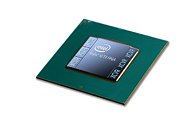Friday, April 20th 2018

Intel Stratix 10: Capable of 10 Trillion Calculations per Second
(Editor's Note: Intel says the Stratix 10 contains some 30 billion transistors - and they say that's more than triple the amount in CPUs that run in the fastest desktop processors today. They're really the ones to know it, since Intel has decided to cut on disclosing transistor count on its CPUs for some time now. The amount of data these FPGAs can process in a single second is nothing short of mind-blowing, though: Intel says they can process the data equivalent to 420 Blu-ray Discs... in just one second. If that doesn't spell an unimaginable future in terms of processing power, I don't know what does.)
Because of the Intel Stratix 10's unique design, it can whip through calculations at blinding speeds - often 10 to 100 times faster than the chips in consumer devices. Intel Stratix 10 FPGAs - the latest version came out in February - are capable of 10 TFLOPS, or 10 trillion floating point operations per second. The Stratix 10 is the fastest chip of its kind in the world.FPGAs, or field programmable gate arrays, are a special class of computer chip that is surging in importance with the rise of applications like speech-recognition, artificial intelligence, next-generation wireless networks, advanced search engines and high-performance computing. Unlike traditional central processing units (CPUs) that power today's laptops and desktops, FPGAs can be customized - or reprogrammed remotely and on the fly - to perform highly specialized computing tas
Source:
Intel
Because of the Intel Stratix 10's unique design, it can whip through calculations at blinding speeds - often 10 to 100 times faster than the chips in consumer devices. Intel Stratix 10 FPGAs - the latest version came out in February - are capable of 10 TFLOPS, or 10 trillion floating point operations per second. The Stratix 10 is the fastest chip of its kind in the world.FPGAs, or field programmable gate arrays, are a special class of computer chip that is surging in importance with the rise of applications like speech-recognition, artificial intelligence, next-generation wireless networks, advanced search engines and high-performance computing. Unlike traditional central processing units (CPUs) that power today's laptops and desktops, FPGAs can be customized - or reprogrammed remotely and on the fly - to perform highly specialized computing tas


23 Comments on Intel Stratix 10: Capable of 10 Trillion Calculations per Second
www.semiwiki.com/forum/content/2439-gpu-vs-fpga.html
Later today they will sneak onto the AMD campus and fill their R&D labs with thousands of balloons.
EDIT:
yep... www.altera.com/products/fpga/stratix-series.html
Intel only in name.
1) It was designed, at least in part, by Intel.
2) It was a completed design that was re-designed for the Intel manufacturing process.
In either case, "Intel only in name" is a false statement.
But that DSP fits a very specific use case and it's extremely limited in terms of programmability and robustness. GPUs are , in nature , much more programmable and flexible but that comes at the cost of computational capability. So how are those GPU breaking 100Tflops then ? Well they simply integrate the same fixed function DSP type hardware blocks that I've just mentioned , so there is nothing special about this. To answer your question , GPUs aren't really braking 100Tflops , it's the additional hardware blocks inside of them that do that but those are essentially more or less the same type of things that power products like the Stratix as well. (By the way , you might have mistaken Tflops for "Trillion operations" it seems , GPUs still do calculations within TeraFlops)
This chip would have been built with or without Intel was the sentiment behind that statement.
Come on, Intel, pass the joint already :D
I feel that after their acquisition by Intel, there's just more buzz around their product announcement. Either because of Intel's marketing trying to market it to AI-this, accelerator, coprocessor-that, or just because it's a release from Intel (come on, do we get to see this much coverage when they're still Altera, or if it's from Xilinx, or Lattice?)
Achieving 10 Tflops with an FPGA is certainly a big feat , but depending on the application it might be better to go ahead and make your own custom silicon or get something that already exists on the market. Intel certainly isn't looking to take away market share from Nvidia/AMD with this , these things are simply meant for an entirely different market.To be honest it looks to me like that buyer didn't really knew what he was supposed to look for in the first place if that was the case.
Well, that wouldn't be a first, would it?
If that's how they hope to run even these sorts of businesses , they are thoroughly screwed.